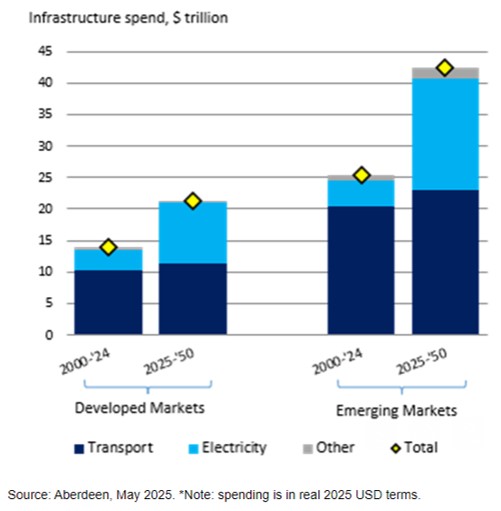Alt Investments
Major Economic Powers Must Ramp Up Infrastructure Spending ‚Äď Study

With a number of large asset and wealth managers becoming more involved in the infrastructure investment arena, a new report from a fund management house explains the reason why. Growth, it says, will have to be dramatic for countries to solve energy, transport and other needs.
UK- based Aberdeen Investments has underscored the reasons why infrastructure-related asset management is a strong trend by predicting that the world’s largest economies will need to spend around $64 trillion on physical infrastructure by 2050 to keep modern economies moving.
The spending target must be met by the middle of this century. The rise equals 1.7 per cent of global gross domestic product per annum and is almost two-thirds higher than the $39 billion spent on infrastructure investment between 2000 and 2024.

Aberdeen looked at 47 countries, modelling how their economies’ infrastructure needs would change by 2050 based on a range of factors including productivity, demographic change and urbanisation. It then calculated the cost of meeting those infrastructure needs.
Several firms, such as BlackRock and Vontobel (see an example about the latter firm here) have made a point about intensifying their focus on infrastructure investment. Infrastructure covers a wide range of activities. There is often (but by no means always) an association with government. Roads, railways, ports, docks, airports, student accommodation, sports facilities, power stations and grids tend to be built either by states, or the state regulates the pricing at the retail end, as well as dealing with matters such as compulsory purchases and planning. (See an analysis here.)
‚ÄúPhysical infrastructure ‚Äď such as road and rail, power generation and utilities ‚Äď is a ‚Äėkeystone‚Äô within the building blocks of growth. Good infrastructure cuts the cost of doing business, for example by lowering the cost of producing goods and moving them around the country,‚ÄĚ Robert Gilhooly, senior emerging markets economist at Aberdeen, said. ‚ÄúBut the sums needed just to ‚Äėkeep the lights on and wheels turning‚Äô are enormous. We expect that the private sector will be increasingly required to help finance these infrastructure needs, as governments are squeezed by high debt levels and geopolitical pressures to spend more on defence.‚ÄĚ
Emerging markets account for $43 trillion of the total required spend, reflecting their greater development needs and faster economic growth. Developed markets, the report said, must spend $21 trillion. Transportation and power generation make up the bulk of physical investment needs.
The study said that investment in global road networks, which need to expand by 7 million kilometres, remains the single largest infrastructure expense. This expansion, alongside substantial maintenance costs of existing roads, is likely to total $28 trillion, little changed vs the prior 25 years (only $1.7 trillion more).
Power is the area requiring the next biggest new investment injection. Rising power needs, the electrification of transport, and the pivot towards renewable energy, mean that global power generation capacity will need to rise from 8,000 Gigawatts (GW) to over 21,000 GW (+165 per cent) by the middle of this century, at a cost of $27 trillion. This is almost $20 trillion more than the cost over the prior 25 years and could be pushed higher still by power-hungry new technologies, such as artificial intelligence data centres, the report said.
